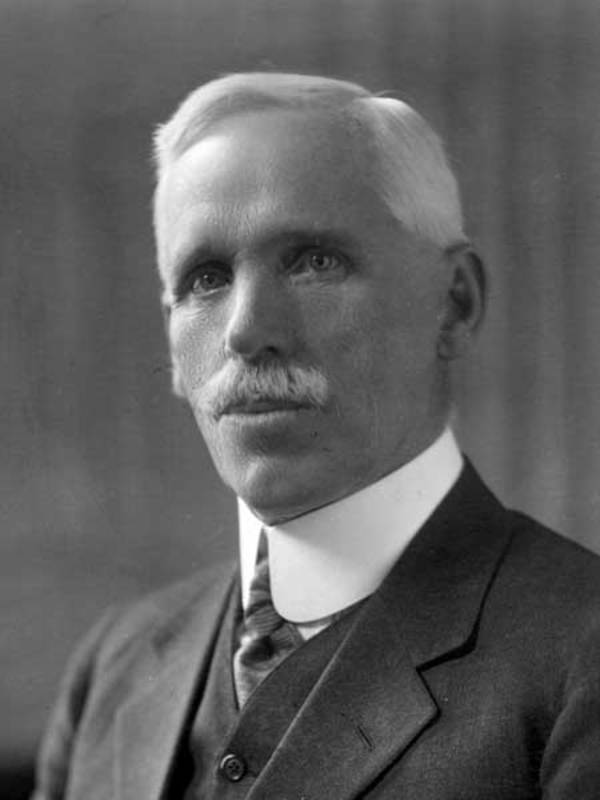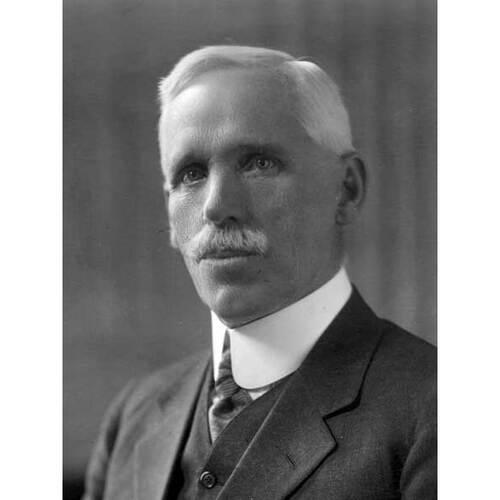
Source: Link
ARMSTRONG, JAMES WILLIAM, teacher, physician, and politician; b. 14 Jan. 1860 in Auburn, N.S., son of James Armstrong, a teacher and farmer, and Elizabeth Pearce; m. 7 April 1897 Mary Campbell in Winnipeg, and they had one son and two daughters; d. there 26 Feb. 1928 and was buried in Elmwood Cemetery.
James W. Armstrong attended Pictou Academy in Nova Scotia, taught school in the province to finance his higher education, and graduated from Acadia College, Wolfville, in 1888 with honours in political economy and history. After travelling west to Manitoba in 1889, he taught for one year at Brandon Collegiate Institute. He enrolled at the Manitoba Medical College and graduated in medicine and surgery in 1893. The next year he opened a practice in Gladstone.
Optimism and boosterism were rife in the west at the turn of the century as railways added branch lines, opening new areas for settlement. In Gladstone, Armstrong did what he could to help the town succeed. By 1899 he had an interest in a drugstore and the neighbouring jewellery store, behind which he had his office, and also in a variety of other businesses: the local newspaper, a livery stable, a boarding-house, and the Gladstone Electric Light and Telephone Company. He was involved in the building of a Baptist church which opened in 1900. The Board of Trade, of which he was treasurer, produced a booklet extolling the virtues of Gladstone.
In addition Armstrong had a busy medical practice. He took a keen interest in public health and served on the provincial Board of Health from 1897 to 1899. He also held a provincial appointment as district health officer. In this post he dealt with a serious outbreak of diphtheria in 1899, tracing contacts and ensuring that cases were isolated. The next year, to further his expertise in hygiene and infectious diseases, he studied at Guy’s Hospital in London, England. In 1910 he was appointed inspector of health by the Department of Indian Affairs for the South Lake Manitoba area; in addition he served as health officer for the town and rural municipality of Westbourne. To meet the demands, he kept fast horses and had permission to use a velocipede car on the railway. He also made an agreement with the Canadian Northern Railway to obtain a pass in exchange for free advertising in the Gladstone Age. His first automobile was delivered on 12 June 1909.
In 1907 Armstrong had been elected to the Legislative Assembly for the Liberal party in the constituency of Gladstone. He would be re-elected in 1910, 1914, 1915, and 1920. Especially after the election of 1910, he took a major part in debates, in opposition to the administration of Rodmond Palen Roblin*. In 1915 the Liberals came to power during a scandal over the construction of the Legislative Building. Armstrong was appointed provincial secretary with responsibility for municipal affairs and the Board of Health in the government of Tobias Crawford Norris*. Among the many pieces of reform legislation brought in by the new government in 1916 were measures which he had supported while in opposition, such as the Manitoba Temperance Act and the School Attendance Act. Presenting amendments to the Public Health Act on 29 Jan. 1916, Armstrong announced that the Board of Health would be reorganized with a permanent staff in order to carry out an active campaign against tuberculosis and infant diseases, increasing prevention in the rural areas. With this extended mandate, the board hired public health nurses, the first in Canada. Speaking to the board’s report during the session of 1918, Armstrong was able to point to favourable results after only one full year of operation. Deaths of children under two years caused by diarrhoea and enteritis had dropped from 424 to 277. The nurses had examined 12,179 children.
With the expanded services introduced by the government, the capital commitments made by its predecessor, and the demands of the war and its aftermath, the Norris regime risked unpopularity by raising taxes. Its majority was reduced in the election of 1920, it was defeated in the house in 1922, and in the election of 18 July it was swept away by candidates of the United Farmers of Manitoba. Armstrong did not run.
Curling and shooting were among Armstrong’s favourite pastimes. In retirement he managed his business interests and enjoyed golfing. While in Victoria in early 1928 Armstrong took ill and returned to Winnipeg, where he passed away.
AM, P 2187-92. Man., Legislative Library (Winnipeg), Biog. scrapbooks; Hansard scrapbooks, Manitoba Free Press (1907–20), Winnipeg Telegram (1907–20). Private arch., R. A. [Stevens] Malaher (Winnipeg), Family bible; Geneal. research done by Merle Armstrong of Waterloo, Ont. Gladstone Age (Gladstone, Man.), 21 Feb., 7 March 1907; 17 June 1909; 20 May 1915. Manitoba Free Press, 29 Jan. 1916, 9 Feb. 1918. CPG, 1907–22. Gladstone’s glory years, 1901–1910, comp. A. E. MacLennan (Gladstone, 1981). Ross Mitchell, Medicine in Manitoba; the story of its beginnings ([Winnipeg, 1955?]). W. L. Morton, Manitoba: a history (Toronto, 1957). Record of the graduates of Acadia University, 1843–1926, arranged by classes, ed. A. C. Chute (Wolfville, N.S., 1926). F. H. Schofield, The story of Manitoba (3v., Winnipeg, 1913).
Cite This Article
Rosemary Malaher, “ARMSTRONG, JAMES WILLIAM,” in Dictionary of Canadian Biography, vol. 15, University of Toronto/Université Laval, 2003–, accessed January 10, 2026, https://www.biographi.ca/en/bio/armstrong_james_william_15E.html.
The citation above shows the format for footnotes and endnotes according to the Chicago manual of style (16th edition). Information to be used in other citation formats:
| Permalink: | https://www.biographi.ca/en/bio/armstrong_james_william_15E.html |
| Author of Article: | Rosemary Malaher |
| Title of Article: | ARMSTRONG, JAMES WILLIAM |
| Publication Name: | Dictionary of Canadian Biography, vol. 15 |
| Publisher: | University of Toronto/Université Laval |
| Year of publication: | 2005 |
| Year of revision: | 2005 |
| Access Date: | January 10, 2026 |



